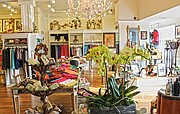RETAIL
Diane Merrick Looks Back on 50 Years in Fashion
Call it the end of an era for Los Angeles boutique retail. Diane Merrick announced last month that she was closing her 45-year-old, self-named Diane Merrick boutique. Most likely, she is the last of her pioneering generation of boutique retailers to close operations.
This group of independent retailers pioneered the California look, which has since been embraced around the globe. Merrick’s boutique was particularly well-known as a place where some stars of California fashion got their start.
Among those who worked at the boutique were the founders of Juicy Couture, Gela Nash-Taylor and Pamela Skaist-Levy; Claire Stansfield of the C&C California T-shirt label; and Tracey Ross, who ran her own influential, self-named boutique in Los Angeles for nearly 20 years from the 1990s to 2009.
The closing sale at Merrick’s boutique, located at 7407 Beverly Blvd. in Los Angeles, is scheduled to wrap up in June. California Apparel News recently caught up with Merrick to talk to her about her time in Los Angeles retail and what she plans to do next. Here’s what we learned.
California Apparel News: What was the best thing about being a boutique retailer?
Diane Merrick: Playing store. You get up in the morning, you have a big smile on your face. You can’t wait to see who will come in. There’s no better thing in the whole world. I love going to work. I love my customers. I love what I’m selling. … It was a big decision to close, but I’m 80 and it is time to move on. I’ve been thinking about it for two years, and I’m going to find something equally as fabulous and do it.
What was the secret to your business longevity?
I wake up in the morning and I can’t wait to get started. I’m always here. I don’t like being away. It’s a lifestyle. I like visiting with people and seeing what’s new. It’s made up for not having children.
What made your store different?
The store is so glorious with a mix of what is old and new. You can pick up a new T-shirt and a vintage decanter. The store has been a wonderful concept; the mix in the store with my beautiful crystal, candlesticks and cashmere. Everything is interspersed on tables, and there are big, big candelabras. You expect Liberace to come out any second. People love it.
How has business changed?
The people who used to sell to me have opened stores nationally and internationally: James Perse, Splendid,Theory, Vince. One by one, they left me at the gate. And a lot has changed in the past 15 years, between Amazon and the Internet, department stores discounting clothes right away, the advent of Forever 21 and H&M. Competition is fierce. In 2008, the economy took a toll on business. People’s tastes have changed. How we dress and go to work is totally different than how we dressed 15 years ago or 45 years ago. Everything is casual. You can go to the finest restaurants and everyone is wearing yoga clothes. Years ago, a great pair of trousers and a jacket were fabulous. But now everyone is wearing a cashmere cape. Cashmere is hot. You can go to a black-tie event and wear a cape and sneakers.
How did people dress when you started your boutique?
Women would wear beautiful suits to work. I had to hold off certain sizes for people. It could be $800. I had $10 to $15,000 days. It was fabulous. Cashmere sweaters set the tone. The baby tees came out so the belly button would show. Parallel pants, low-rise [styles]. English people came out with riding pants. Through it all, I stayed loyal to cashmere.
What was the wildest decade for business?
The ’70s and the ’80s. I didn’t know the ’70s was such a big deal, and I was part of it. During the ’80s, I remember Julia Roberts coming in the store barefoot. I remember Sarah Jessica Parker when she was dating Robert Downey Jr. He was buying things for her. I remember the Juicy women and helping young designers.
In the ’70s, there were years I was making a lot of money. Boxes would come in. We didn’t have time to open them. People would buy [right out of the box]. But it came to a point where everything was online, and everything was discounted. Everything is the bottom line. But I survived.























